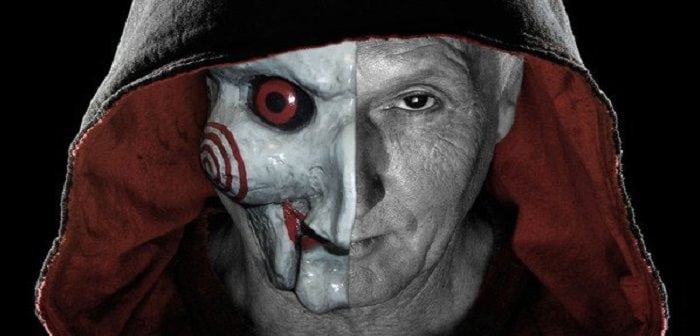
The games are about to begin again. After a seven year hiatus, the most successful horror franchise of all time (as per the Guiness Book of World Records) returns to the big screen for Halloween. Across seven movies John Kramer, aka Jigsaw (Tobin Bell), and his band of protégés found evermore inventive ways to make victims learn the value of life, or die trying. Over time the films became near synonymous with the derogatory label ‘torture porn’. Yet more than any other horror series to date, Saw gave viewers a rich array of interconnected plot threads that combined to tell a complex but coherent story. Indeed, unlike the patronising cinema worker serving my friend once joked, you can’t just jump in halfway through, and fully get it, like you can with Friday the 13th etc. Of course this doesn’t mean every entry was equally good. As such, to celebrate the release of the eighth entry, Jigsaw, I’m rank the series to date. Oh and yes, there will be spoilers.
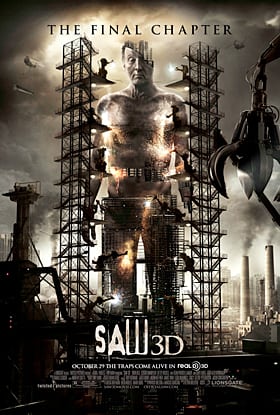
7. Saw 3D: The Final Chapter
Directed by Kevin Greutert
Rounding off the original series with by far its weakest entry. Saw 3D ups the scale at the expense of plot coherence and enjoyment with an over the top finale. Sadly the ongoing saga goes out with a whimper, as the ongoing rivalry between Jill and Hoffman has all the tension of a lucky dip at Poundland. The latter going full Terminator on the police is a particular low point, and glaringly out of sync with the mood established across six films before. Our main plot follows Jigsaw survivor Bobby Dagen (Sean Patrick Flanery), who tours his memoirs of the time he used his nipples to pull himself to safety and a trap. Ok, so it’s his pectorals if you want to be picky. Regardless, if this sounds a little silly, it’s meant to be because it turns out he’s a fraud. Problem is, Team Jigsaw are not folks you want to be spreading lies about and the bullshitter finds himself waking up in a house of traps. And, in some predictable irony, will eventually risk his nipples for freedom. That we never even find out what happens to him suggests the creative team gave as much of a shit as the audience. Given how rushed it feels, it genuinely surprises me that this and part 6 share a director.
Unfortunately Saw 3D is unable to rise above all the very worst aspects of its forerunners. There’s a dislikeable main cast, an almost completely disposable secondary cast and a reliance on visual gimmicks over storytelling. Moreover, with a total of 11 traps, Saw 3D revels in the violence more than any of the others, making the film what people who didn’t see the rest assume they’re all like. At points it plays with black comedy, with the opener in particular laughing at itself and the audience, although for the most part it’s too goofy to be taken seriously and too unpleasant to be fun – making the 3D misjudged. Admittedly it’s nice to see original star Cary Elwes limping back in as Dr. Lawrence, following a prolonged court case with Lion’s Gate. Although, as per the series regular Tobin Bell, he’s reduced to little more than a cameo that resembles fan fiction rather than a genuine arc. The signature twist can’t save it either, with a reveal that all but the least attentive viewers will see coming. Here’s hoping Jigsaw does something to remove the bad taste.
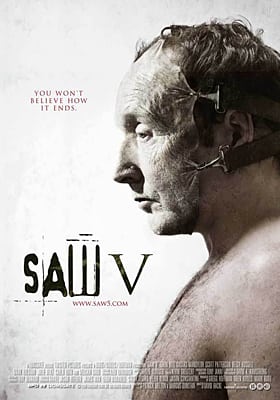
6. Saw V
Directed by David Hackl
I was really toying with where to put this one in the list. There’s a lot to like about it, with the flashback sequences detailing how Hoffman came to be Jigsaw’s apprentice being among the best bits of the endless lore and adding further thematic and dramatic depth to the series. Firstly, because it depicts Hoffman as being somewhat tragic, in his love for his sister, but also because it cleverly revisits some of the previous scenes to show some of the iconic traps getting set up. Tobin Bell is on form, with some show stealing scenes – save for an unintentionally funny bit where he yells that killing is “distasteful” before adding the qualifier “to me”. Yet while the soap opera is mostly on points, there’s very little to keep you invested in either of the main plots.
The Hoffman vs. Strahm battle of wits is entertaining if unremarkable, with the former behaving needlessly suspiciously whenever he interacts with people and really stretching the series’ limited credibility with what he can do by himself. A once winning formula is getting tired, and the emphasis on procedural doesn’t help it given how little we know or care about Strahm aside from his blink and you’ll miss it scene from the second. Elsewhere, five strangers pass through five rooms with five traps and find they’re vaguely connected by something boring about a building getting set alight etc. It’s far from thrilling stuff, with the solution to their predicament being so darn obvious, and the characters being so darn forgettable that your mind will wander. Consequently, this is the entry you’re least able to describe as “the one where…” such and such a thing happened. The ending is also workmanlike, with the inevitable finale having none of the impact of its predecessors – unlike the ludicrous tagline, you will believe it all too easily. Yeah, Strahm dying is kind of big, except he never felt like an especially credible threat in the first place. Still, at least the pendulum sequence is pretty cool.
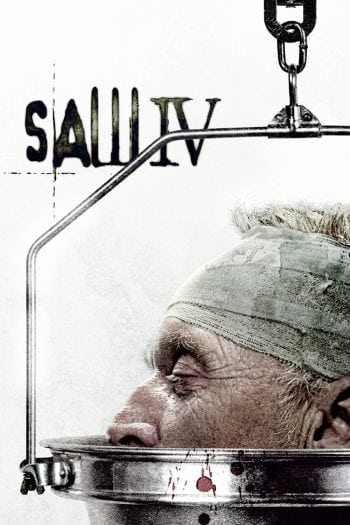
5. Saw IV
Direct by Darren Lynn Bousman
Last year I spoke to Bousman about his decision to part ways with the franchise for the barmy Repo: The Genetic Opera. He said he took a hell of a lot of pride in his time with Saw, but didn’t want to be treading water. I can sympathise, because around this point that’s exactly what it felt the series was starting to do. Boldly picking up where the third left off, with Jigsaw on the autopsy table, the fourth had a fighting spirit but failed to live up to the original trilogy. The central story with Lieutenant (Lyriq Bent) had a confused moral message, with him going on trial for being too keen to save people… Huh? Sure, it’s a big dumb torture film etc. But that’s just silly! And in the absence of a personal arc the kills felt gratuitous. Furthermore, the focus on quantity vs quality of traps meant that some had a diminished impact and they all felt like they were over in seconds just so it could keep its flawed real time premise going for the second two thirds.
Yet where the fourth film really succeeded was visually: Bousman has a distinct steampunk look about his work, and here he shows what he’d learned from two doing the second and third. Some moments are surprisingly tranquil, with the key trap involving ice blocks in particular being aesthetically impressive. Then there’s the raw brutality of the opening kill: the blind and the mute fighting. Cuts between scenes are also elaborate, keeping the frantic pace going steadily. Part four also did a shrewd job of expanding the universe, filling in the backing story. Here we get to see the genesis of Jigsaw, with John Kramer losing a son and scoring his first ever kill via a nasty DIY contraption. That the series can spend so much time in the past without losing viewers’ interest shows how rare a baddy John Kramer is. In addition, extending Jill’s role beyond the flash in the third was a good idea, giving Jigsaw a context and some hope outside his cancer, along with organically offering a new antagonist. At this point it wasn’t clear just what she thought of her husband’s legacy, and that made it all the more intriguing. Less convincing was the reveal of Hoffman’s involvement, with a clever twist being undermined by his character having so little screen time before. Nonetheless, for adding flesh to the bones of the series, this was an important entry, and deserves to be commended.

4. Saw II
Direct by Darren Lynn Bousman
Living up to the surprising nature of the first film, the second Saw takes a risk by having its villain arrested in the first few minutes. What follows is an intense stand-off with him, and new franchise anti-hero Detective Eric Mathews (Donnie Whalberg), on the other side of the interrogation desk. As they discuss the philosophy of Jigsaw’s work, monitors show a group of eight people locked in a house that’s been infiltrated with a deadly nerve gas – including prior victim turned associate Amanda (Shawnee Smith). The group need to search the house, completing grizzly challenges so they can find the antidote to live long enough to see the front door automatically open.
Although director Darren Lynn would go on to do better things, including the next entry in the series, this was a remarkable statement of intent. It’s uncompromising and, in the best way, grimy. Some of the kills are shocking, with a needle pit being the stand out, and the makeup is meticulous. While most franchises will keep their villain hidden, or have them swoop in for the kill and run, Saw stood out for giving it’s one a voice. Jigsaw is onscreen for a lot of the running time and it’s a testament to the writers, plus Tobin Bell, that he never feels overexposed and actually became more charasmatic. If that’s not enough, there is a one-two of punches at the end that both catch the audience off guard. Really, this is a strong follow up. The only real flaw is some shallow characterisation, with one housemate in particular being relegated to the role of cartoon villain just to add more drama to an already heightened situation. In contrast to the careful character work with Jigsaw, it feels cheap and needless.
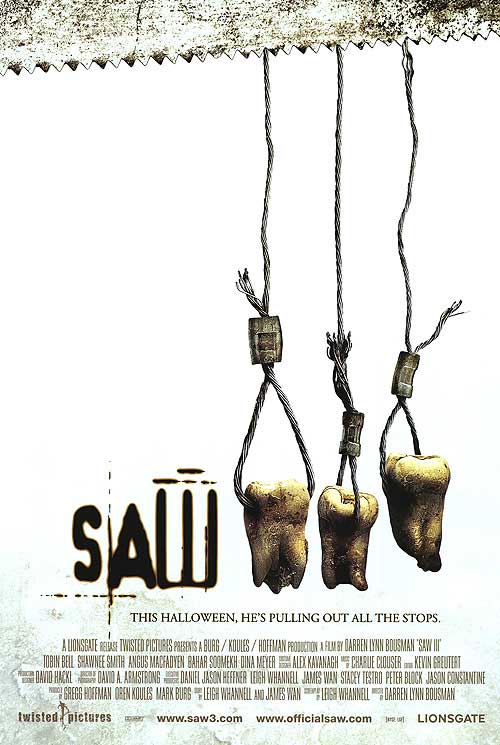
3. Saw III
Direct by Darren Lynn Bousman
Had the series been rounded off here, like planned, it would have made for a brilliant ending – with Kramer’s gleeful death scene, as he shows anyone can be corrupted, feeling climactic. I can only imagine that must have been a tough call for the guys in suits. As per usual there are two parallel plots. For the first, viewers following Jeff (Angus Macfayden), whose son has been killed in a hit and run. With the second we are literally taken into the mind of John Kramer. Looking worse for wear, he is given dangerous, but lifesaving, neurosurgery by the emotionally cold doctor Lynn (Bahar Soomekh), in a shotgun collar, who is secretly married to Jeff. To make things even more difficult for Kramer & Co., police are on his trail again, as more bodies are showing up in gory traps they can’t possibly escape.
This is an excellently crafted film with some strong, if far-fetched, surprises along the way. The traps are better than any other point in the franchise, with the rack being truly horrific and the pigs in the meat grinder being stomach churning. The violence is also more visceral than any before or after. Jeff’s struggles, as he decides whether or not he wants to save the people in them, are well judged too – putting the audience in an interesting moral position of being complicit but sympathetic. Although as accomplished as these contraptions are, they’re arguably less interesting than the power plays going on by Kramer’s deathbed. Shawnee Smith is a standout, playing Amanda as very loving of her mentor, as well as being deeply psychologically damaged. Her competitive back and forth with Soomekh, as she removes a tumour, adds some dramatic beats to the grizzly thriller, which builds up to a first-rate climax that sees a room of people die. As Jigsaw reveals it was Amanda’s test instead of Jeff’s, the heart break and regret are well earned. Make no mistake, the closing packs and emotional punch. But not as much as the next one on our list…
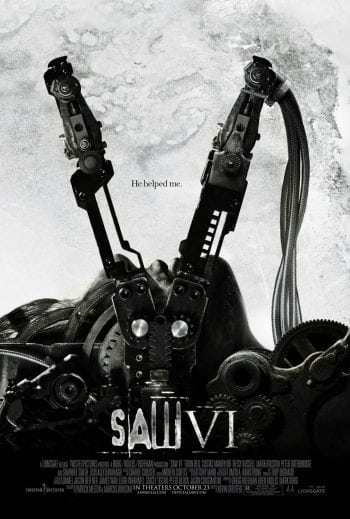
2. Saw VI
Directed by Kevin Greutert
Very close to being my number one. Saw VI was an unexpected highlight in the series. While the first deserves to be commended for its snappy script, this one offers by far the most complete character journey. At first, insurance executive William (Peter Outerbridge) is as unsympathetic a victim as you can get. In his opening scene we see him turn away someone for treatment on shoddy grounds – an equation we later find out he invented. He also happens to have used this equation to turn down John Kramer for experimental treatment – bad idea. Some shared dialogue between them will bite him in the ass, as Kramer accuses him of choosing who lives and who dies. Waking up in a disused zoo, following the usual pig mask abduction, he undergoes an often painful series of trials to save as many of his co-workers as he can. For a sixth entry in a horror franchise to nakedly attack the American healthcare system is gutsy – nevermind that it does so in a way that was far more progressive than their at the time ‘left wing’ president. And darn does its statement get powerful. No it isn’t I, Daniel Blake, but then its still primarily a torture film. The stressful closing minutes in particular, after all that’s come before, are genuinely devastating. They’re made more so because it feels like William really has learnt. However, by this point his actions have resulted in too many ripples. As he was warned, it is the dead who have claim over his soul.
Unlike the other sequels, this is the only instance where the main plot is more engaging than the ongoing Jigsaw saga. However, Hoffman and Jill get some memorable scenes as they duke it out (even if Hoffman is barely even hiding in plain sight now). Tobin Bell also does some of his best work to date, with angry attacks on corporate excess and private healthcare. Regarding the other key staple, the traps are more inventive than the fourth or fifth outings, and this time far more personal. In particular, the carousel is a work of demented brilliance, where a crying William has to shotgun his fellow suits. Then the twist at the end, where we find out whose game it really is, also works well resulting in a dark, but very poignant irony. An underrated gem that I so wanted to give this the top spot. However, as much as I love it, that’d be disingenuous. So I’ll settle on calling it one of the all-time great horror sequels and way better than can be reasonably expected of any part six.

1. Saw
Directed by James Wan
Yes, despite tight competition, this was always going to be the winner. The original, and still the best. Building upon their accomplished short, collaborators James Wan and Leigh Whannell devised a great calling card for Hollywood. Mostly taking place in one room, Saw was a gritty chiller with a brilliant riddle at its core. Adam (Leigh Whannel) and Dr Gordon wake up chained to opposite sides of a dilapidated bathroom with no memory of how they got there. In the middle is a dead body, with a tape recorder, and elsewhere they find a selection of saws just sharp enough to cut through ankle. Could this be the work of the Jigsaw killer? And are these men being completely honest with each other?
As much as the jigsaw pieces are supposed to symbolise what’s missing from victim’s lives, they also represent the intriguing mystery the audience try and piece together. Sadly, this is an element that could only be fully realised once. Although the sequels add much to the setup, they cannot replicate the same fear of the unknown: a constraint which necessitated that the traps became the recurrent element. Saw was less about them (although the few they have are excellent) and is more about voyeurism (hence the title) and suspense.
While Adam and Dr. Gordon’s increasingly desperate situation inside unravels, in parallel we follow an obsessive hunt by Detective David Tapp (Danny Glover). The horror and thriller elements are effortlessly combined, and the result is often edge of the seat, scary and completely unforgettable. In particular the closing scene pulls the rug out from under the viewer’s feet, with one of the greatest endings that modern genre cinema has to offer. No it isn’t always perfect: the acting is fairly amateur and a badly done car chase makes you wonder how James Wan ever got his hands on the Fast and Furious films. But the key set pieces, including that intense camera scene, the frightening iconography and the pace are all better handled here than any other entries. The heavy beats soundtrack also beats you into submission, especially during the closer, and I’m glad the theme became a franchise fixture. A modern masterpiece that more than almost any other movie shows how to deliver big chills on a meagre budget.
So there we have it – one of the greatest horror franchises ranked. On a personal note, this is the series I’ve watched the most by far. I’ve seen each of them several times, and even seen them all in one sitting. Yet despite my fandom, first I didn’t welcome a new one after the time away, figuring the moment may have ended with the decline of the torture subgenre. But then after learning the Predestination directors, Michael and Peter Spierig, are at the helm I’m excited. Besides, the trailer was bloody good. With a surprising lack of competition this October, here’s hoping it won’t be ‘game over’.
Jigsaw is released in cinemas today.

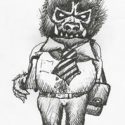
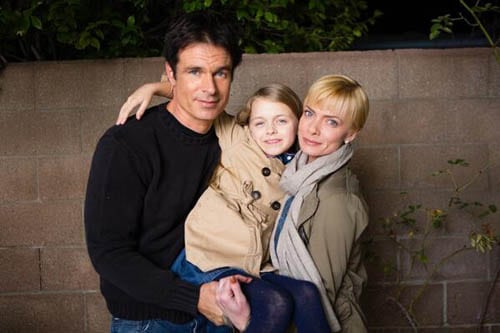


Be the first to comment